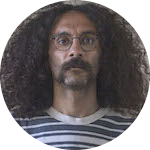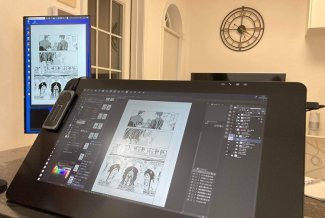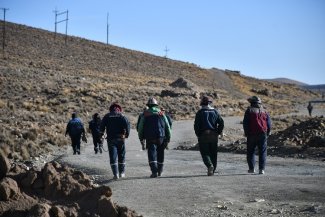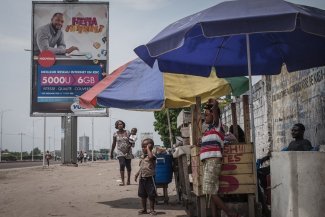‘Informal settlements’, ‘camps’, ‘shelters’, ‘improvised housing’: no matter how officials refer to refugee shantytowns, all of these terms are too grandiose to describe the living conditions of Syrian refugees in Lebanon.
Refugee settlements are scattered all across Lebanon; a country that is about half the size of Slovenia in Europe, and about three times smaller than El Salvador in the Americas. Nonetheless, this country of 4.4 million people hosts over 1.5 million refugees, according to a recent report by Amnesty International.
Indeed, only 10 countries host more than half of the world’s refugees. Amongst them, Lebanon has the highest per-capita concentration: nearly one-in-five people living in Lebanon is a refugee.
“Small nations must not bear the consequences for large nations’ wars,” said Sejan Aziz, Lebanon’s Labour Minister, in a late September press conference in which he proposed a plan to return refugees to ‘safe zones’ in Syria.
But Aziz is not the only politician who has expressed concerns about the influx of Syrian refugees into Lebanon. The Ministry of Labour’s plan was announced just a few days after Lebanon’s Minister of Foreign Affairs and Emigrants Gebran Bassil said in an interview with Al Monitor: “Lebanon cannot be the only one receiving refugees. We can give humanitarian assistance to people in need, but we cannot be a political recipient for the problems of Syria.”
However, according to experts working for the United Nations High Commissioner for Refugees (UNHCR), without full international humanitarian law safeguards in place, the safety of civilians would be hard to guarantee in so-called ‘safe zones’ inside Syria. Observers have noted that this means the repatriations are unlikely to take place.
“A ‘safe zone’ that fails to take into account requirements as defined by international law potentially jeopardises the safety of people who end up being drawn to it,” Tatiana Audi, a spokesperson for UNHCR in Lebanon, tells Equal Times.
The reality of camp life
Meanwhile, 87 kilometres east of Beirut in Bekaa Valley, refugee slums have appeared on every corner. The presence of Syrian refugees in Lebanon is no longer temporary. For over five years they have eked out a miserable existence, oftentimes by living under the thin plastic sheets which provide their only shelter from Lebanon’s harsh summer sun and below-freezing winters.
Today, over 360,000 Syrian refugees reside in Bekaa, one of the poorest regions in Lebanon. The Lebanese government has so far refused to permit the establishment of formal camps on its territory due to its experience with the 450,000 Palestinian refugees that have lived in Lebanon for over 60 years.
“What can we do?” asks Khaled, a refugee in his late fifties from Homs in central Syria. “If we could go back, we would have gone already. Who do you think likes to live in these tents,” Khaled says, his voice empty from grief but full of anger.
He escaped the war in Syria in 2013 and has been living in a camp on the outskirts of al-Marj in Lebanon’s Bekaa Valley ever since. Before the war, Khaled was a farmer in the Baba Amr district of Homs. Now, as he talks about the life he and his family of nine endure, he expresses a deep wariness.
“I don’t trust anyone or anything anymore: neither the doctors who vaccinate our children, nor the medication they give us,” he says. “My infant boy died last year and their medicine didn’t help at all. I don’t know for sure, but I suspect that maybe they give us expired medication, the medicine that they themselves cannot take anymore.”
The prolongation of the war in Syria has dramatically increased the level of distrust between Lebanese people and the Syrian refugees they are hosting. Like in many other countries, Syrian refugees in Lebanon face racism, xenophobia and discrimination.
But even with all these challenges, the peace of their new home is preferable to living in a warzone. However, there isn’t much in the way of comfort available to the Bekaa Valley refugees. Their makeshift homes are made from whatever materials they can find: bricks from abandoned houses, concrete masonry units, plastic sheets bearing the UNHCR logo, old doors and even tree branches.
These flimsy huts are supposed to shelter refugees through their sixth consecutive winter of displacement. Last year, a number of refugees in the area froze to death. Refugees in the area fear the same dreadful fate awaits them.
“This winter will be the same as the previous ones,” says 28-year-old Abou Mohammad. He has been living in the al-Marj camp since 2013, after he lost his parents to shelling in Syria. When he arrived in al-Marj, there were only 10 refugee huts; today, there are over 250 families in the area. “But nothing has changed and no one is ready for the cold winter,” he says.
“The Bekaa region is one of the coldest areas in Lebanon with repeated waves of snowfall, strong winds and heavy rain,” explains Audi. She knows more needs to be done to help Syrian refugees in Lebanon but the problem is one of resources.
“Six years into the refugee crisis, there is still a strain on the Lebanese economy and public institutions. They were already unprepared to absorb this large number of refugees,” says Audi. International assistance has come from various international aid agencies and governments but it is still not enough. Earlier this year, the Lebanese government requested US$2.4 billion in aid for the next five years to provide support to Syrian refugees in Lebanon. However, it should be noted that previous aid commitments are yet to be fulfilled.
The lost generation
Displacement, winter, distrust, fear of deportation and a lack of humanitarian aid are not the only concerns of Syrian refugees in Lebanon. Those who have survived the gunfire and bombs now watch helplessly as their children sink into a quagmire of illiteracy.
Before the war, literacy rates were at 95 per cent for Syrians between the ages of 15 and 24 years old. Today, five years after the beginning of the conflict, a quarter of a million Syrian children are growing up in Lebanon without an education, according to a report from Human Rights Watch.
Due to the lack of capacity and resources in public education in Lebanon the enrolment of refugee children in public schools is severely limited. In addition, various studies have shown that Syrian children in Lebanese schools not only have to endure the psychological trauma of escaping a warzone, but they also face discrimination and violence as well as difficulties getting used to language and social differences.
Refugee teachers are attempting to teach Syrian children at informal schools scattered throughout the camps, but it is an uphill struggle.
“Our main goal is to prepare the children to enter Lebanese public schools, and integrate them within host local schools,” Rakan al-Khaibar, 26, vice principal of a tent school in al-Marj tells Equal Times.
“But it is very difficult to keep the children at school,” he adds. “Because of the living conditions in the camp, many children drop out of school between the ages of 10 and 14.”
Most of these children are forced to work as cheap labour on construction sites, on farms or as street hawkers in Lebanese towns and cities, human rights experts say.
Even those children who continue with their studies find it difficult to learn in the over-crowded classrooms of the tent schools. For instance, 320 students study in al-Marj’s six-room school.
Outside the tent school, Khaled talks to Fatemeh, a ten-year-old student, who sits at the entrance of a shack with a notebook and pencil provided by the local NGO, Jusoor. “Do you want to see what our children learn at school?” asks Khaled. “Wait and see what she has learnt after three years”.
Khaled asks Fatemeh to write her first and last name. After a prolonged silence, during which Fatemeh hovers her pencil over the paper, she writes her name in Arabic. “How slow you are!” jokes Khaled. “Ok, now write ‘I am Fatemeh, Moustafa’s daughter.’” The little girl gazes into the eyes of the elderly man, puzzled and embarrassed. “We haven’t learnt this yet.”









